 The 42nd Chikaku Colloquium 2009 (The annual meeting of perception study in Japan)
The 42nd Chikaku Colloquium 2009 (The annual meeting of perception study in Japan)Hosted by the Kyushu University
Kyukamura-Shikanoshima, Shikanoshima, Fukuoka, Japan
March 22, 2009
 The 42nd Chikaku Colloquium 2009 (The annual meeting of perception study in Japan)
The 42nd Chikaku Colloquium 2009 (The annual meeting of perception study in Japan)
Hosted by the Kyushu University
Kyukamura-Shikanoshima, Shikanoshima, Fukuoka, Japan
March 22, 2009
Memories of the two excellent Gestalt psychologists Professors Kaoru Noguchi and Walter Ehrenstein
by Akiyoshi Kitaoka
since March 16, 2009 handout
1. Photos
Demo off line
2. The book and the paper
Kaoru Noguchi (Ed.) (2007) Psychology of Beauty and Kansei: New Horizons of
Gestalt Perception ![]()



Kitaoka, A. (2007) Gestalt and aesthetics of visual illusion. In K. Noguchi (Ed.), Psychology of Beauty and Kansei: New Horizons of Gestalt Perception, Tokyo: Nihon University College of Humanities and Sciences, pp. 681-688 (with color-printed pages pp. 7-11). PDF
 Noguchi, K., Kitaoka, A., and Takashima, M. (2008) Gestalt-oriented perceptual
research in Japan: Past and present. Gestalt Theory, 30, 11-28. Figures PDF (Walter was the action editor!)
Noguchi, K., Kitaoka, A., and Takashima, M. (2008) Gestalt-oriented perceptual
research in Japan: Past and present. Gestalt Theory, 30, 11-28. Figures PDF (Walter was the action editor!)

Figure 7. Watercolor illusion and apparent transparency. (a) The watercolor illusion. The corridor area appears to be tinted orange, to be veiled, and to be figure. (b) Achromatic watercolor illusion. The corridor area q appears to be veiled, to be darker than the surround b though they are the same in luminance, and to be figure. The alphabets a, b, p and q correspond to those shown in (c) or (d). (c) A possibly novel image of apparent transparency. It appears that a black square bearing a square window in the center is placed on the white background, and that a translucent disk appears to be in front of the black square and to cover the window entirely. The disk always appears to be transparent in front, i.e. unique transparency (Adelson and Anandan, 1990; Anderson, 1997). (d) Metelli's figure demonstrating unique transparency. The disk always appears to be transparent in front.
3. Transparency and brightness illusions
<Transparency> one of the most attractive phenomena in Gestalt psychology
The first one of my opinions is
 X-junctions determines the types of transparency.
X-junctions determines the types of transparency.
Adelson-Anandan-Anderson's X-junction model of perceptual transparency
Adelson, E. H., & Anandan, P. (1990). Ordinal characteristics of transparency.
Paper presented at the AAAI-90
Workshop on Qualitative Vision, July 29, 1990, Boston, MA.
Anderson,
B. L. (1997). A theory of illusory lightness and transparency in monocular and
binocular images: the role of contour junctions. Perception, 26,
419-453.
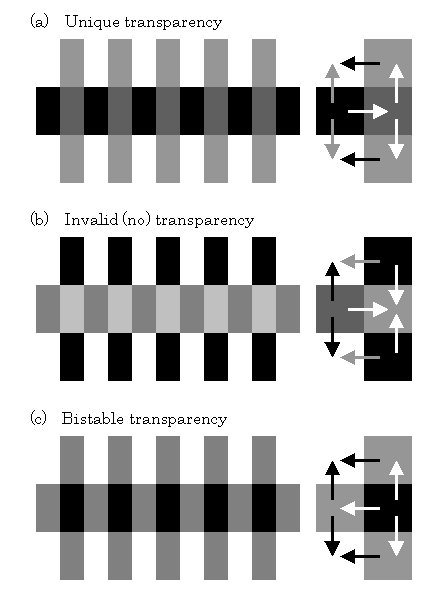
(a) Unique transparency that follows
Metelli's (1974) formula, in which gray bars are seen transparent and perceived
as if they were located in front of the horizontal black occluder. Since the
apparent depth order is unique, this type is called unique transparency. (b) The
figure invalid for transparency. (c) Bistable transparency, in which the
vertical grating can be seen either in front of or behind the occluder. Arrows
indicate contrast polarity ("lighter than").
<Kitaoka, A., Gyoba, J., Kawabata, H., and Sakurai, K.
(2001). Perceptual continuation and depth in visual phantoms can be explained by
perceptual transparency. Perception, 30, 959-968.>
Kitaoka, A. (2005) A new explanation of perceptual transparency connecting the X-junction contrast-polarity model with the luminance-based arithmetic model.. Japanese Psychological Research, 47, 175-187. PDF
Chikaku Coloquium 2004 (Japan)
The second one of my opinions is:
 Low-contrast parts tend to appear to be transparent in front.
Low-contrast parts tend to appear to be transparent in front.
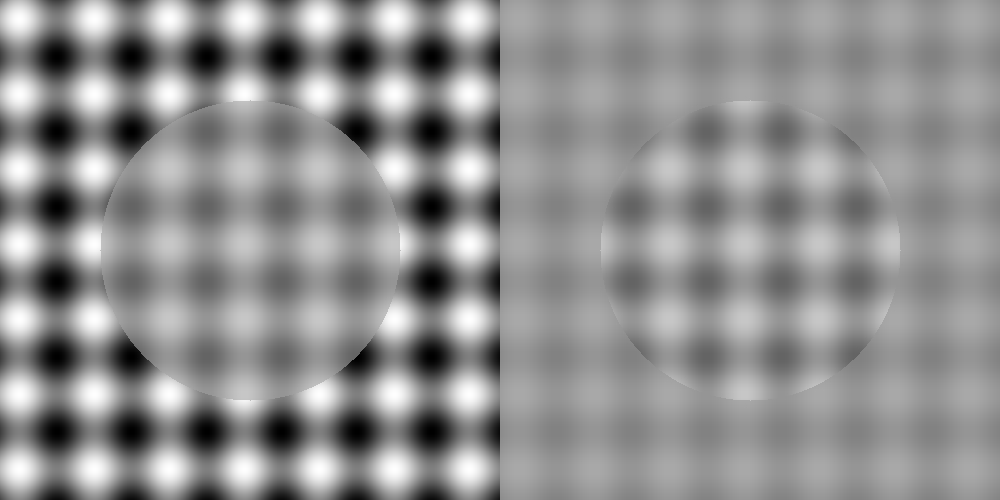
(contrast contrast)

The third one of my opinions is
 Darker parts tend to appear to be transparent in front.
Darker parts tend to appear to be transparent in front.

Kitaoka, A. (2005) A new explanation of perceptual transparency connecting the X-junction contrast-polarity model with the luminance-based arithmetic model.. Japanese Psychological Research, 47, 175-187. PDF
The fourth one of my opinions is
 Low-spatial-frequency parts tend to appear to be transparent in front.
Low-spatial-frequency parts tend to appear to be transparent in front.

Takashima (2008) proposed the sumi painting
effect in the Japanese Journal of Psychology.  <November 26,
2008>
<November 26,
2008>
Takashima, M. (2008) Achromatic watercolor effect: About requirement of formation of sumi painting effect. Japanese Journal of Psychology, 79, 379-384 (in Japanese with English abstract).

(A) Watercolor illusion (Pinna, Brelstaff and Spillmann, 2001). Although the whole area except waving borders is homogeneously white, the corridor part appears to be tinted green in the upper panel while the outer and inner parts appear to be tinted so in the lower panel. (B) Achromatic watercolor illusion. Although the whole area except waving borders is homogeneously white, the corridor part appears to be tinted gray in the upper panel while the outer and inner parts appear to be tinted so in the lower panel (Noguchi, Kitaoka and Takashima, 2008). (C) Sumi painting effect. Although the whole area except waving borders is homogeneously gray, the corridor part appears to be tinted lighter in the upper panel while the outer and inner parts appear to be tinted so in the lower pane (Takashima, 2008). These figures are drawn by Akiyoshi Kitaoka.
References
Takashima, M. (2008) Achromatic watercolor effect: About requirement of formation of sumi painting effect. Japanese Journal of Psychology, 79, 379-384.
Noguchi, K., Kitaoka, A., and Takashima, M. (2008) Gestalt-oriented perceptual research in Japan: Past and present. Gestalt Theory, 30, 11-28. Figures PDF request to me
Pinna, B., Brelstaff, G., and Spillmann, L. (2001) Surface color from boundaries: A new 'watercolor' illusion. Vision Research, 41, 2669-2676.
<from Illusion news 4>
Professor Kaoru NOGUCHI, a Gestalt
psychologist and a researcher of experimental aesthetics in Japan, passed away
on 25th July, 2006, at the age of seventy-one. <July 31, 2006>
His contribution to the study of visual illusion
1. Geometrical illusion, especially
further development of the work of Professor Shiro MORINAGA, his
teacher
He classified Morinaga's 'paradoxical' illusions into three categories, one of which is known as the Morinaga misalignment illusion.
Noguchi, K. (1982) The theory of visual illusion: Morinaga'a paradox in positional shifts. Psychology (Tokyo: Science-sha), 29 (Special issue of visual illusion), 40-47 (in Japanese).
2. Proposal of the rule that illusion magnitude positively correlates with the degree of aesthetic feeling
Noguchi, K. and Rentschler, I. (1999) Comparison between geometrical illusion and aesthetic preference. Journal of Faculty of Engineering, Chiba University, 50, 29-33.
I love this paper.
3. His last illusion was a lightness illusion!
A new illusion was proposed in a meeting in Japan! <April 10, 2006>

produced by Midori Takashima 2006
(April 10)

produced by Akiyoshi Kitaoka 2006
(April 10)
The
Noguchi-Takashima effect (the sumi painting effect)
A new illusion!
The regions surrounded by light borders appear to be lighter than they are while those surrounded by dark borders appear to be darker than they are.
Noguchi, K. and Takashima, M. (2006) "Watercolor effect" and Gestalt factors. Paper published in the 39th Chikaku (Perception) Colloquium (March 23-25, 2006), Takayama-shi, Gifu-ken, Japan.
Akiyoshi's comments: It resembles but is different from the Craik-O'Brien-Cornsweet effect and the watercolor effect. Although Noguchi and Takashima did not claim this effect a new one, I felt that this is quite new, so I persuaded them to give permission to show it in my webpage as a new effect. It should also be noted that the enhancement of brightness induction or filling-in given by the wavy configuration is the invention of Professor Baingio Pinna. Dr. Midori Takashima is a young perceptionist, who was a student of Professor Kaoru Noguchi.
4. He brought up many excellent perceptionists.
Brief Personal History of Professor Kaoru
Noguchi
Special field of study:
Perception (Gestalt
psychology), Traffic psychology, Psychology of art
Education:
Chiba
University, Chiba, Japan
Bachelor of Arts in Psychology, Mar
1957
Tokyo Metropolitan University, Tokyo, Japan
Master of Arts in
Psychology, Graduate School of Humanities, Sep. 1960
Work
Experience:
Sep. 1961 - Assistant at College of Arts and Sciences, Chiba
University, Chiba, Japan
Jan. 1966 - Instructor at College of Arts and
Sciences, Chiba University, Chiba, Japan
Oct. 1966 - May. 1968 Research
associate at York University Graduate School, York, Canada
Apr. 1968 -
Assistant professor at College of Arts and Sciences Chiba University, Chiba,
Japan
Dec. 1979 - Professor at College of Arts and Sciences,
ChibaUniversity, Chiba, Japan
Jun. 1980 - Aug. 1980 Visiting Scientist at
Ludwig Maximilians Universität, Munich, Bundesrepublik of Deutchland
Sep.
1980 - Nov. 1980 Visiting professor at University of Trieste, Trieste,
Italy
Apr. 1994 Transfer to Faculty of Engineering, Chiba University,
Chiba, Japan
Sep 1999 Retired from Chiba University, Chiba, Japan
Oct
1999 - Professor, College of Humanities and Sciences, Nihon University, Tokyo,
Japan,
Nov. 1999 Honorary professor of Chiba University, Chiba,
Japan
Feb. 2005 Retired from Nihon University, Tokyo, Japan
<Email reply to Walter from Akiyoshi> (February 15, 2007)


"Wave-line color
illusion"
(Sohmiya, S. (2007) A wave-line colour illusion. Perception, 36, 1396-1398)
The white background behind the orange waves appears to be tinted orange.
produced by Akiyoshi Kitaoka 2009 (February 19)
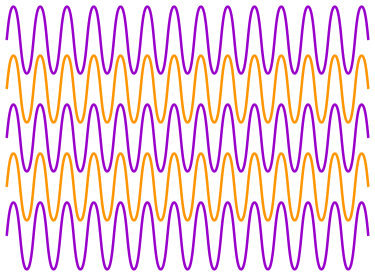

"Wave-line color illusion"
The gray background behind the blue waves appears to be bluish.
produced by Akiyoshi Kitaoka 2009 (March 16)


"Wave-line brightness illusion"
(Sohmiya, 2006, personal communication)
 The white background behind the gray waves appears to be darker than the rest. This effect was discovered by Seiyu Sohmiya in 2006 (personal
communication).
The white background behind the gray waves appears to be darker than the rest. This effect was discovered by Seiyu Sohmiya in 2006 (personal
communication).
produced by Akiyoshi Kitaoka 2009 (February 19)

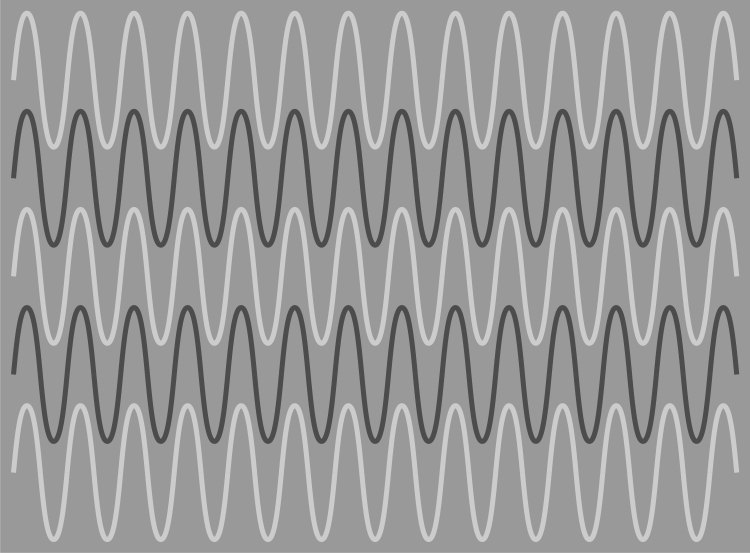
"Wave-line brightness illusion or brightness assimilation"
The gray background behind the dark gray waves appears to be darker than the rest.
produced by Akiyoshi Kitaoka 2009 (March 16)

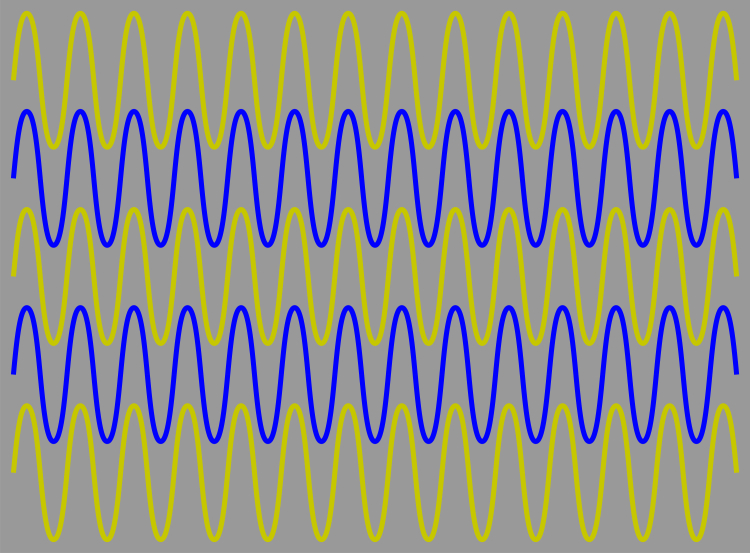
"Wave-line color illusion or color assimilation"
The gray background behind the blue waves appears to be bluish.
produced by Akiyoshi Kitaoka 2009 (March 16)

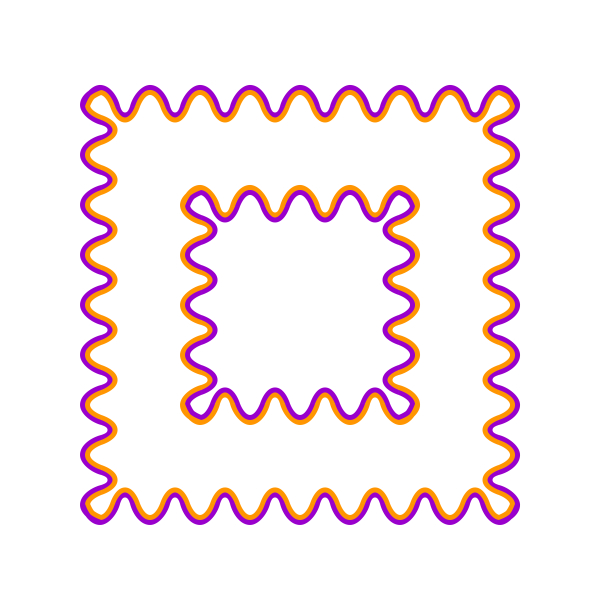
"Watercolor illusion"
(Pinna, B., Brelstaff, G., and Spillmann, L. (2001) Surface color from
boundaries: A new 'watercolor' illusion. Vision
Research, 41, 2669-2676.)
The corridor part appears to be tinted orange.
produced by Akiyoshi Kitaoka 2009 (March 16)
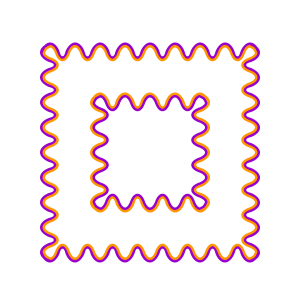

"Watercolor illusion"
The corridor part appears to be tinted blue.
produced by Akiyoshi Kitaoka 2009 (March 17)

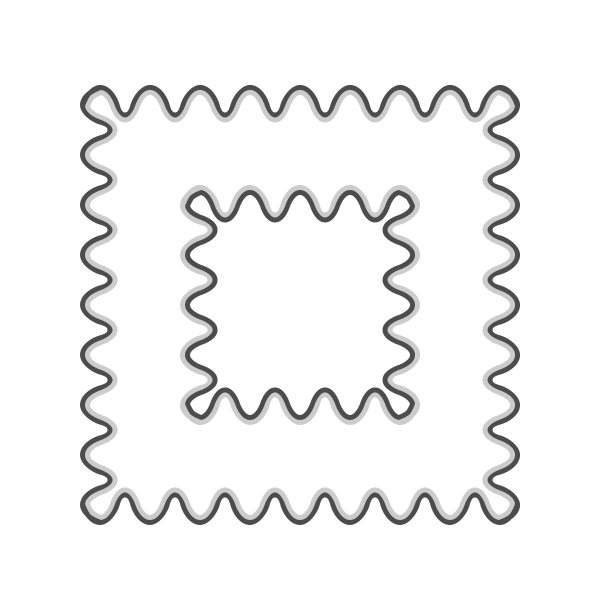
"Watercolor brightness illusion"
 The corridor part appears to be dimmer than the rest.
The corridor part appears to be dimmer than the rest.
produced by Akiyoshi Kitaoka 2009 (March 17)
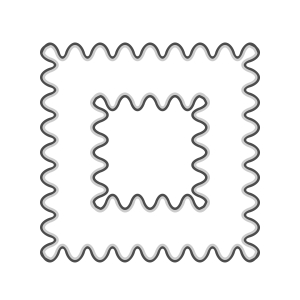

"Sumi painting effect"
(Takashima, M. (2008) Achromatic watercolor effect: About requirement of
formation of sumi painting effect. Japanese Journal of
Psychology, 79, 379-384 (in Japanese with English abstract).)
The corridor part appears to be lighter than the rest.
produced by Akiyoshi Kitaoka 2009 (March 16)
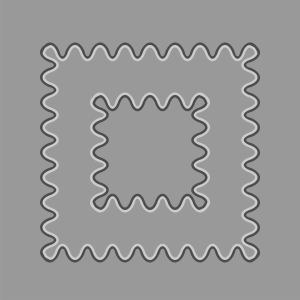
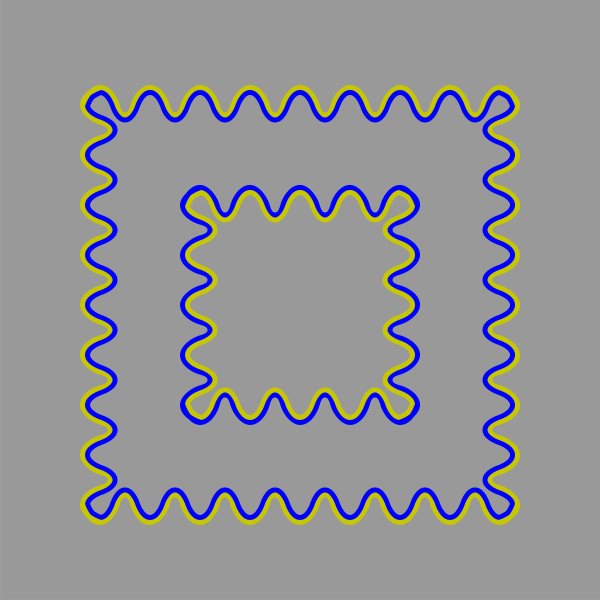
"Chromatic sumi painting effect"
The corridor part appears to be tinted orange.
produced by Akiyoshi Kitaoka 2009 (March 16)


"Neon color spreading, Type Diamond"
(Van Tuijl, H. F. J. M. (1975) A new visual illusion: Neonlike color spreading
and complementary color induction between subjective contours. Acta Psychologica, 39, 441-445.)
The diamond part appears to be tinted orange.
produced by Akiyoshi Kitaoka 2009 (March 17)


"Neon color spreading, Type Diamond"
The diamond part appears to be tinted bluish.
produced by Akiyoshi Kitaoka 2009 (March 17)

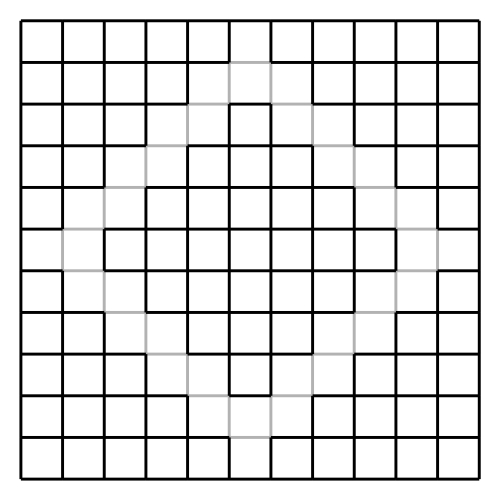
"Neon brightness spreading, Type Diamond"
 The diamond part appears to be dimmer than the rest.
The diamond part appears to be dimmer than the rest.
produced by Akiyoshi Kitaoka 2009 (March 17)

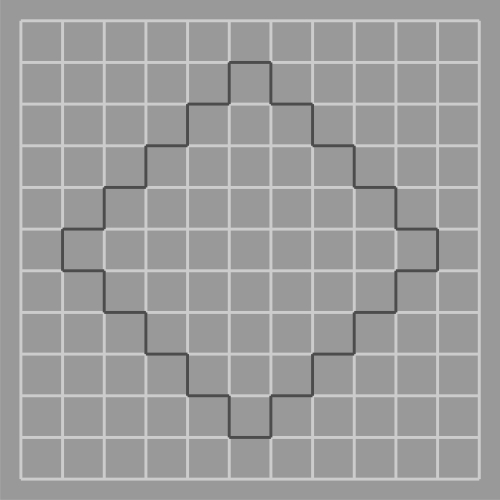
"Brightness assimilation? Type Diamond"
The diamond part might possibly appear to be darker than the rest.
produced by Akiyoshi Kitaoka 2009 (March 17)


"Color assimilation? Type Diamond"
The diamond part might possibly appear to be tinted blue.
produced by Akiyoshi Kitaoka 2009 (March 17)

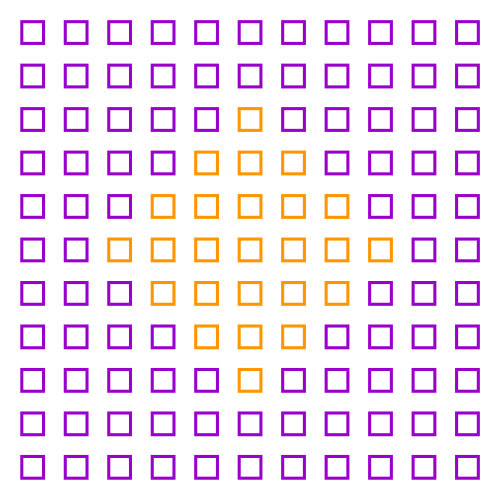
"Neon color spreading, Type Separated"
(Van Tuijl, H. F. J. M. and Leeuwenberg, E. L. J. (1979) Neon color spreading
and structural information measures. Perception and Psychophysics, 25,
269-284.)
The diamond part appears to be tinted orange.
produced by Akiyoshi Kitaoka 2009 (March 17)
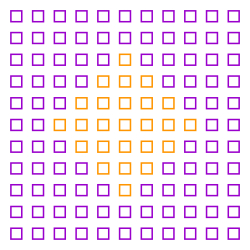

"Neon color spreading, Type Separated"
The diamond part appears to be tinted bluish.
produced by Akiyoshi Kitaoka 2009 (March 17)


"Neon brightness spreading, Type Separated"
 The diamond part appears to be dimmer than the surround.
The diamond part appears to be dimmer than the surround.
produced by Akiyoshi Kitaoka 2009 (March 17)
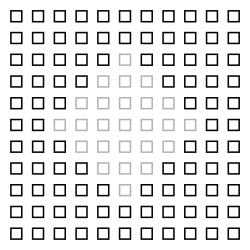
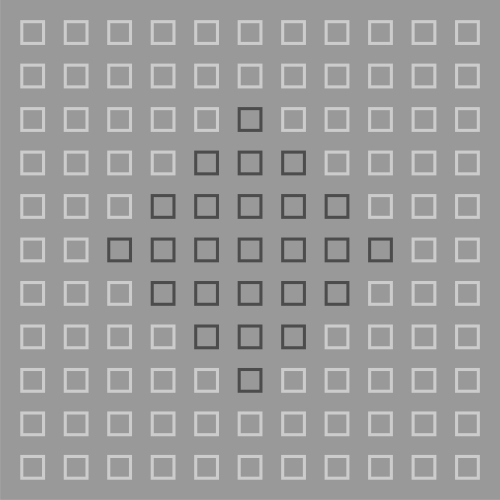
"Brightness contrast? Type Separated"
The diamond part appears to be darker than the rest.
produced by Akiyoshi Kitaoka 2009 (March 17)


"Neon color spreading, Type Separated"
(Van Tuijl, H. F. J. M. and Leeuwenberg, E. L. J. (1979) Neon color spreading
and structural information measures. Perception and Psychophysics, 25,
269-284.)
The diamond part appears to be tinted orange.
produced by Akiyoshi Kitaoka 2009 (March 17)
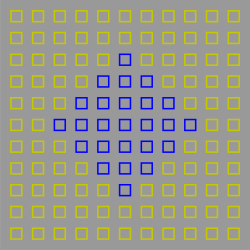

"Neon color spreading, Type Cross"
(Van Tuijl, H. F. J. M. (1975) A new visual illusion: Neonlike color spreading
and complementary color induction between subjective contours. Acta Psychologica, 39, 441-445.)
Translucent orange-color patches appear to be in front of the crosses.
produced by Akiyoshi Kitaoka 2009 (March 17)


"Neon color spreading, Type Cross"
Translucent bluish-color patches appear to be in front of the crosses.
produced by Akiyoshi Kitaoka 2009 (March 17)
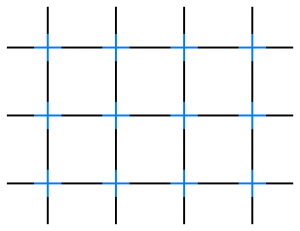
 Here I conjecture that neon brightness spreading is not brightness assimilation.
Here I conjecture that neon brightness spreading is not brightness assimilation.

"Neon brightness spreading, Type Cross"
Translucent achromatic patches appear to be in front of the crosses.
produced by Akiyoshi Kitaoka 2009 (March 17)
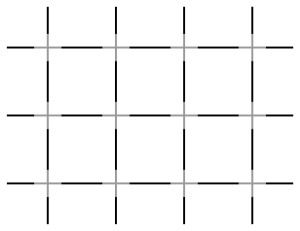
cf.

"Ehrenstein illusion"
(Ehrenstein, W. (1941) Ueber Abwandlungen der L. Hermannschen Helligkeitserscheinung.
Zeitschrift. für Psychologie, 150, 83-91.)
Gaps appear to be brighter than the rest.
produced by Akiyoshi Kitaoka 2009 (March 17)
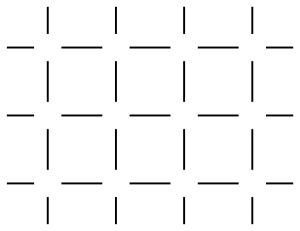
cf.

"Visiome tilt
illusion"
Each rectangular pink background appears to be distorted in which the outer side appears to be longer than the inner one (Ehrenstein illusion).
Copyright Akiyoshi Kitaoka 2008 (December 27)

 Ehrenstein
illusion (Ehrenstein, 1925)
Ehrenstein
illusion (Ehrenstein, 1925)
Visiome Platform is a digital research resource archive for vision
science. The available resources include mathematical models, experimental
stimuli, experimental data, and analytical tools. Visiome
 Click this image, and
a high-resolution bitmap (4800 x 8653 pixel) of this advertising image will be
available.
Click this image, and
a high-resolution bitmap (4800 x 8653 pixel) of this advertising image will be
available.

"Brightness and color assimilation in the cross image"
I do not see the expected effects.
produced by Akiyoshi Kitaoka 2009 (March 17)

"Craik-O'Brien-Cornsweet effect"
Area "A" appears to be lighter than area "B", though they are the same luminance.
produced by Akiyoshi Kitaoka 2009 (March 17)
 Maybe the first!
Maybe the first!

"Paradoxical Craik-O'Brien-Cornsweet effect"
Area "A" appears to be darker than area "B", though they are the same luminance.
Copyright Akiyoshi Kitaoka 2009 (March 17)

"Chromatic paradoxical Craik-O'Brien-Cornsweet effect"
Areas flanked by orange borders appear to be tinted orange.
Copyright Akiyoshi Kitaoka 2009 (March 17)

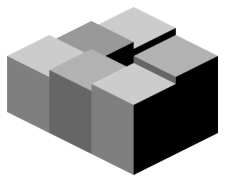 Possibly the first, too.
Possibly the first, too.
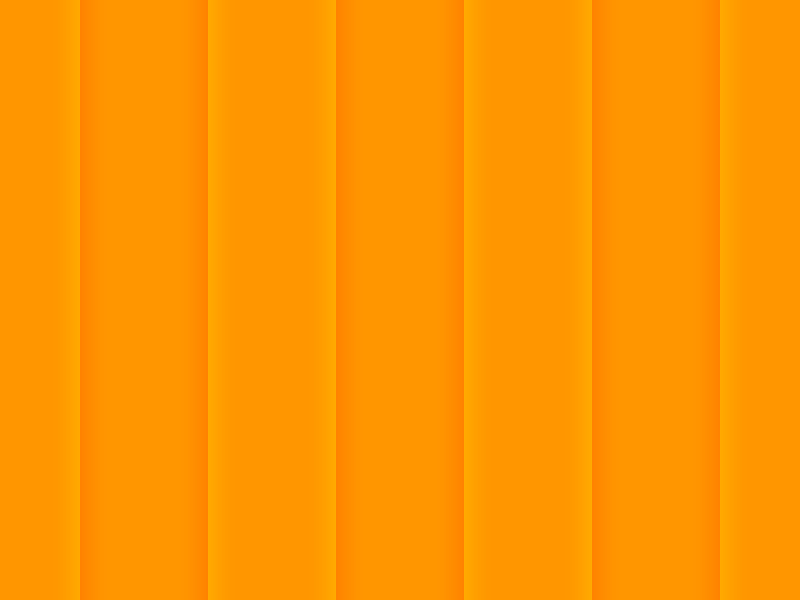
"Chromatic Craik-O'Brien-Cornsweet effect"
Areas flanked by orange borders appear to be tinted orange.
Copyright Akiyoshi Kitaoka 2009 (March 17)
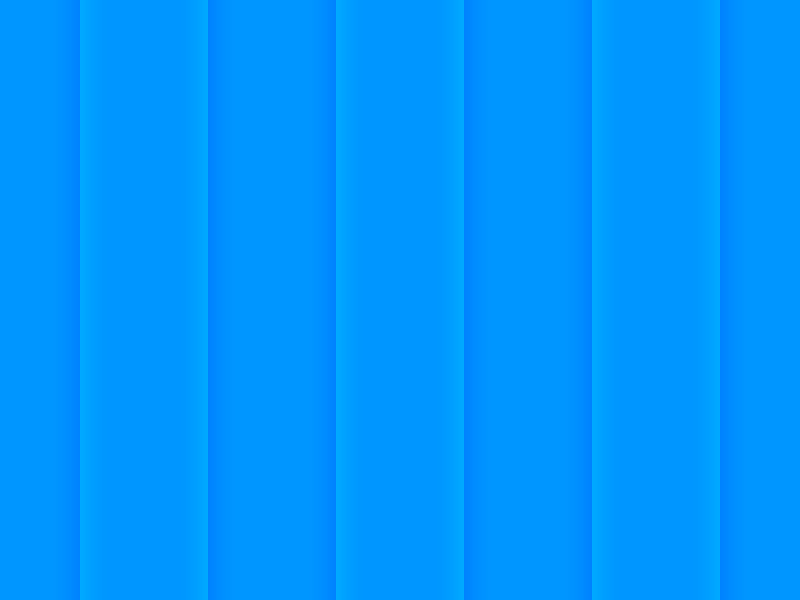

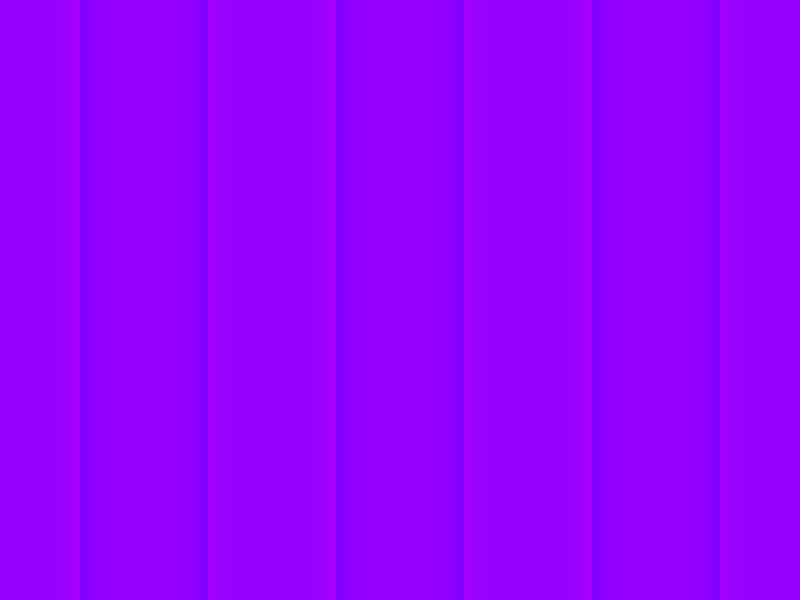
4. Conclusion.
I am deeply indebted to Professors Kaoru Noguchi and Walter Ehrenstein in heaven.
 Thank you!
Thank you! 
 "Impossible Kin-in"
"Impossible Kin-in"
Copyright Akiyoshi Kitaoka 2009 (March 17)
Kin-in = the gold seal discovered in Shikanoshima, Fukuoka, the Kyushu
island
Fukuoka City Museum
The 42nd Chikaku Colloquium 2009 (The annual meeting of perception study in Japan)
Hosted by the Kyushu University
Kyukamura-Shikanoshima, Shikanoshima, Fukuoka, Japan
March 22, 2009